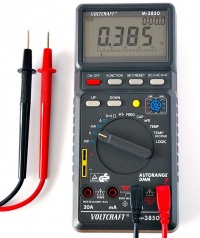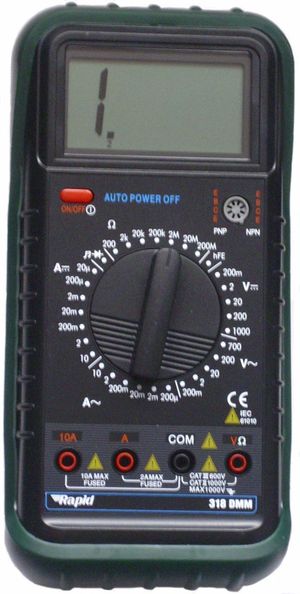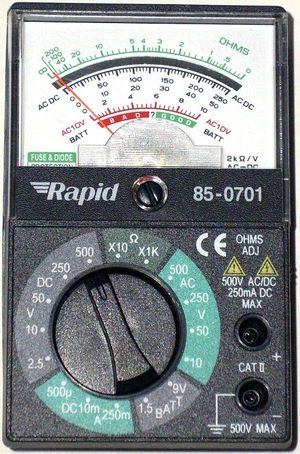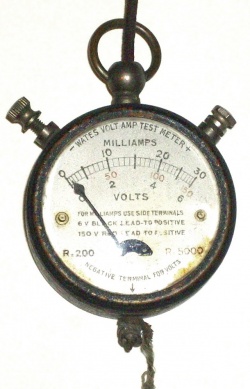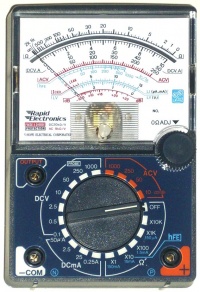Difference between revisions of "Multimeter"
(→Non-rms readings: m) |
|||
| (2 intermediate revisions by the same user not shown) | |||
| Line 138: | Line 138: | ||
[[image:1920s multimeter 3738-7.jpg|250px|right]] | [[image:1920s multimeter 3738-7.jpg|250px|right]] | ||
| − | + | ====Pre-war==== | |
| + | Pre-war metal cased multimeters are rare. They're dangerous, and you can expect a severe shock if you take them anywhere near mains. They also have very low internal resistance, making them little use for electronic work. However meters that look like they came from a previous civilisation aren't hard to spot. They're styled like old pocket watches. | ||
| + | ====Home made meters==== | ||
More modern home made meters occasionally turn up, usually constructed by hobbyists short of pocket money. Such meters typically have no protection or safety features. Metal cased ones too often lack adequate basic [[insulation]], and usually have unsecured wiring prone to coming adrift and touching the case. These are fine for low voltage use, but an unknown quantity on mains. | More modern home made meters occasionally turn up, usually constructed by hobbyists short of pocket money. Such meters typically have no protection or safety features. Metal cased ones too often lack adequate basic [[insulation]], and usually have unsecured wiring prone to coming adrift and touching the case. These are fine for low voltage use, but an unknown quantity on mains. | ||
| Line 225: | Line 227: | ||
==See Also== | ==See Also== | ||
| + | [https://www.youtube.com/watch?v=AK02JakVVPY Hazardous cheapo meters] | ||
* [[:Category:Electrical|Other electrical articles]] | * [[:Category:Electrical|Other electrical articles]] | ||
* [[Special:Allpages|Wiki Contents]] | * [[Special:Allpages|Wiki Contents]] | ||
Latest revision as of 01:44, 6 March 2018
Uses
- Fault finding on electrical circuits & appliances
- Checking remaining battery capacity
- Tracing circuits, eg lighting, sockets, heating, etc
- Finding voltage, polarity & regulation of wallwarts
- Much use in electronics too
Also imperfect for, but still pretty useful:
- Finding faults causing RCD nuisance trips
- Checking earth continuity
With additional equipment:
- Remotely locating cable & circuit breaks
Checking batteries
By Voltage
Measuring battery voltage is a very inaccurate but still useful way to get some idea of remaining capacity.
- Cheap carbon zinc cells discharge from 1.5v down to around 1.1v before they're completely dead. Voltage gives a good idea of charge.
- Alkaline cells are dead by around 1.3v. Voltage gives a good idea of charge.
- Lead acid cells are dead by 1.8v per cell (10.7v for a 12v battery), below which they should not be discharged.
- NiCd & NiMH batteries' charge state can't be found with a multimeter until they're close to flat.
Terminal voltage vs remaining capacity is not in any way linear, terminal voltage remains steady for a large part of the cell's life before deteriorating. The voltage/capacity relationship differs for the various battery types.
Current
Measuring max current delivery gives a better indication of remaining battery life, but is less convenient. A multimeter can only practically do this with zinc carbon & alkaline cells, and coin cells). Never try this with NiCd, NiMH or lead acid, the huge currents delivered can kill a multimeter instantly.
Low current batteries (AA, 9v) may be tested by reading their max current delivery for a second or two on the 10A range. Use a much lower current range for coin cells.
For analogue meters only having a 1A range, and for large cells on the 10A range (eg D cells), its ok to just touch the probe to the battery for a fraction of a second, and note how quickly the needle moves rather than what offscale value it is heading to. This is a simple trick to read currents of above the meter's max capacity. Probes must not be connected for more than a small fraction of a second, and this technique is not usable with digital meters. It probably voids warranties too, and can cause loss of calibration accuracy if done too slowly.
Finding faults causing RCD nuisance trips
RCD nuisance trips are normally caused by earth leakage. A megger is the best instrument to test for mains leakage, as it tests insulation at mains voltage or above, whereas a multimeter typically tests it at 1.5v - 12v. Despite this, a multimeter still picks up the majority of insulation failures, and thus is useful for finding the cause of nuisance trips.
One meter probe is connected to both Live & Neutral of the appliance, and the other is connected to the earth pin or the metal case. This gives a resistance reading, or ideally an open circuit reading. Keep fingers off during testing, as a finger will pass more current than the appliance.
Ensure that every power switch on the appliance is on when leakage testing. If testing a (disconnected from mains) oven for example, all heating elements should be switched to on.
Fault resistance at 1.5v can be very different to the resistance value at 240v, so it is not possible to give a pass/fail threshold value. Any item that passes noticeable current is a possible insulation fail, and the 1 or 2 items with the lowest resistance readings are the prime suspects.
Appliances with line to earth filter capacitors (eg TVs, computers, washing machines) conduct a little momentarily then go open circuit. this momentary conduction doesn't indicate failure, its the steady resistance after that that counts.
Appliances must always be disconnected from the mains when doing this test. Switching off but leaving connected is no good, any readings obtained that way are useless.
A few items are impossible to fully test using this method, namely anything with an electronic controller that switches mains power. Washing machines and touchpad type microwaves are the main examples of this. If necessary washing machine elements and motors can be tested by applying probes direct to the element and motor connections. Microwave transformers ditto.
Fault finding
Multimeters show
- where power is getting to (voltage range) (item powered up)
- what wire is connected where (resistance range) (disconnected from power)
- heater function test (resistance range) (disconnected from power)
- insulation failures (resistance range) (disconnected from power)
- fuses & filament bulbs dead or alive (resistance range) (disconnected from power)
and various other jobs.
Wallwarts
Applying the probes to the dc jack on the voltage scale indicates output voltage and polarity. It will also pick up on the small number of ac output warts: these give no reading on dc range, but read on ac voltage range.
Regulated warts give the same voltage on or off load, so the voltage measured will match the voltage shown on the label. With unregulated warts, output voltage rises significantly with no load, so measured V is higher than indicated on the wart's label by anything from 25% to 50%.
Cable break location
A capacitance range can be used to estimate the position of a break in a cable or circuit. Plug-in leads tend to break at one end; knowing which end means one end can be cut off and the lead repaired.
The technique is to measure the cable's capacitance at each end. Capacitance is proportional to the length of unbroken connected cable, thus the approximate position of the break is easily found. usually the break is near one end, the end that gives lower capacitance.
Meters with self contained capacitance ranges are easy to use, requiring only to touch the probes to the cable without touching the connections with one's hands (which would alter the readings).
Issues
Wrong range, instant destruction
Applying power to the meter probes when switched to the current or resistance ranges can cause instant destruction. Analogue meters are usually very vulnerable in this respect, one mistake can kill them.
No voltage detected
Modern meters are required to have sprung shrouded plugs for safety. The plugs have a habit of coming partway out and no longer connecting. Thus a live wire can give a reading of zero.
Live probe plug
A probe lead coming out when reaching the probes to mains causes a free swinging live connector, and can cause shock. Probe lead plugs should be a stiff fit to avoid this. Loose fitting plugs are common on old meters, and are a safety issue. They can be fixed by very slightly bending the metal pin of the plug.
Explosion
There have been occasional cases of multimeters exploding due to
- application of excess current (eg conecting to mains when on current range) and
- application of excess voltage (eg due to lightning strike when attached to mains wiring)
However this is a fairly rare phenomenon a long way down the list of DIY safety issues.
Many new meters meet certain IEC use categories to improve safety in this respect. Meters without such certification are best not used on high energy circuits, ie those where high voltage and high current are both available.
Other ways to reduce the risk include use of fused probes, and meters that use a different probe socket for current readings.
Non-rms readings
On ac ranges, multimeters don't normally read rms values. They generally read average rectified current, and translate this to an rms value assuming a sine wave. This works fine for sinusoidal waveforms (eg mains voltage), but measuring non-sine waveforms gives wrong reading values. Some often encountered non-sine ac waveforms include:
- TV CRT (tube) heaters
- rectified unsmoothed waveforms
- output from dimmers
- output from invertors & UPSes
- often output from generators under load
- output from electronic lighting transformers
- Current draw by many mains appliances
True RMS reading meters are available, but their price makes them little used for DIY work.
Buying
For DIY use, check the meter has:
- low dc voltage range to measure batteries
- 250v ac or higher range for mains voltages,
- dc current range
- and preferably resistance ranges able to measure from under 1 ohm to megohms
Useful features most meters lack include
- ac current range(s)
- a current range of 10A or more can be useful occasionally
- self contained capacitance measurement to find lead & cable faults
If you're going to use the meter on live mains, it should ideally be IEC category certified.
There are also other ranges and features available, but those are more useful for electronics than DIY.
New
Most new multimeters are now digital. Few don't have the necessary ranges for DIY use.
Where meters are for trade use, Fluke are well known for their robustness & reliability.
New meters cost anything from a couple of pounds to over £1000. Cheap digital meters sometimes suffer from an accuracy issue, in that when the battery gets low some read a bit off for a while before they indicate a low battery. Analogues are inherently immune to this.
Used
Used multimeters meters span the technology range from 1930s Avometers to modern digital instruments. Despite differing appearances, the job these all do is much the same.
Risky rarities
Pre-war
Pre-war metal cased multimeters are rare. They're dangerous, and you can expect a severe shock if you take them anywhere near mains. They also have very low internal resistance, making them little use for electronic work. However meters that look like they came from a previous civilisation aren't hard to spot. They're styled like old pocket watches.
Home made meters
More modern home made meters occasionally turn up, usually constructed by hobbyists short of pocket money. Such meters typically have no protection or safety features. Metal cased ones too often lack adequate basic insulation, and usually have unsecured wiring prone to coming adrift and touching the case. These are fine for low voltage use, but an unknown quantity on mains.
For both the above types, the main risk is shock. With most shocks the victim withdraws their hand very fast, but when you're holding the live item in your hand, as one does with meters, you're in real trouble. There's also the issue of explosion risk when used on high energy circuits.
Making your own
Making low spec analogue meters is quite basic electronics, but with new ones so cheap now its pointless.
Features & specs
Digital or Analogue
Most new meters are now digital. The noticeable differences between digital and analogue moving pointer display are:
- ease of reading (digitals display the number, analogues point to marks on a scale and you get to interpolate)
- robustness (analogue mechanisms are fragile, the meters should never be dropped)
- Analogue meters can be killed instantly by passing heavy overcurrent through them, eg by probing a battery on the 10mA range
Other differences are either trivial for DIY work (eg needle displays show changing values semi-well, whereas digital ones become unreadable) or minor and inconsistent (eg accuracy, where figures for both types overlap over a mostly similar range). In terms of required functions for DIY, both do all the things required.
Voltage
Just about all multimeters of all ages have the required voltage ranges. Its unusual to find ones that don't, though they do exist.
Current
Many meters only have low dc current ranges up to 1A, and no ac current range. This means they won't measure current drawn by mains appliances, but this isn't much done. Low end meters tend to have only current ranges that are too low to be useful for diy.
Resistance
The resistance ranges offered depend more on a meter's position in the market than its age. 1930s meters were pretty much as well specced as modern ones in this respect. For both modern and old meters, low cost models may lack megohm ranges and a range able to measure below 1 ohm. Megohm ranges are useful for finding appliances that trip RCDs, and sub-ohm ranges are useful for testing earthing.
A diode resistance range is common on multimeters now. This doesn't add anything useful for DIY work, and can be regarded as just another resistance range.
Continuity
A continuity range is sometimes included. This is a simple go/ no-go test for cables. These too often have the wrong resistance threshold for DIY work, and the resistance ranges do the job already, making this range of little use.
If it also has an audible indicator it becomes very handy, as its then not necessary to look at the meter to get a go/ no-go check, or even to position the meter within view. Most meters lack audible indication.
Capacitance range
Measuring capacitance is not often useful for DIY. However it can be used to estimate the position of breaks in leads and ring circuits, and to determine which end of a failed lead to cut off to repair it.
There are 2 different types of capacitance ranges found on multimeters:
- Self contained capacitance measuring - just apply the probes and it reads the capacitance.
- Ranges that can read capacitance value if connected to the mains via the capacitance under test.
Unfortunately the latter are much more common, especially on used meters, and much less useful.
Using the basic type of capacitance range
Lower spec meters that can only read capacitance by connecting to the mains via the capacitance can not safely be used at mains voltage for such tasks. However a lower voltage higher frequency supply is just as effective, so for example a 12v (240v/20) 1kHz (50Hz x20) source will do the same job. Admittedly not many DIYers have such things, but some of us do. Its also possible to use 50Hz 24v and scale the resulting readings up to get the correct value.
Buying a new meter is usually easier though!
Other ranges
Some meters also have:
- transistor hfe tester
- dB scale is common on analogue meters
- Range doubler or tripler switch (improves readability and accuracy on analogue meters)
None of these are much use for DIY work.
An ignition timing range is sometimes seen on meters intended primarily for car work. This can be of use to diy car mechanics if working on old mechanically controlled engines. (Its not too hard to make an ignition timing reading circuit for multimeters without this range if you can do some electronics).
Convenience
1930s meters sometimes used a plethora of sockets, with either some range changes being achieved by plugging the probes into the right socket, and some with the range dial, or sometimes all selections made with the sockets. This makes changing range slower, but the overall effect on work rate is minor if you dont use the meter on a daily basis. Occasionally this mixed approach is seen on meters from less distant decades too.
The main issue with these meters is that range selection mistakes are easier to make, and analogue meters are vulnerable to range selection mistakes. In practice they seem to be ok, but care is necessary with range selection.
Autoranging
Autoranging digital meters switch range by themselves as needed. This can improve work rate in some situations, but is of limited use for DIY, since the quantities measured don't span multiple decade ranges. 240v is either there or not, batteries don't stray outside of 1-15v, etc.
If buying an autoranger, the ability to set the range manually is sometimes an advantage for more demanding work, but this option isn't always included.
Probes
Some meters come with prod, croc clip and hook probes. If not, they can be added later, if wanted.
Safety
Old meters mostly lack shrouded probe plugs, making them a bit less goof-proof. Old meters often have probe lead plugs that pull out easily if you overstretch with the leads. This is a safety issue, but is easily fixed by bending the plug pin very slightly.
Many old meters lack any current range fusing, increasing the risk of failure and slight risk of injury if misused.
Old meters lack IEC category certification, making them a bit more vulnerable to explosion due to indirect lightning strike, internal faults etc. This is a very rare event though, and old meters are still used in industry, including some Avometers from the 1930s.
Rubber covers
A rubber jacket makes the meter more likely to survive a drop.
